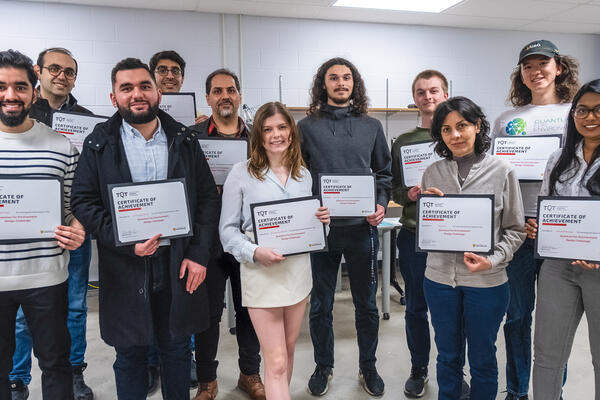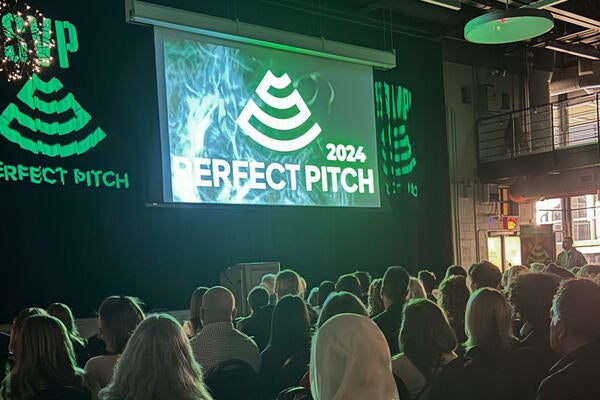
Uniting science and art through STEAM education
The faculties of Science and Arts introduce a new theatre and performance course tailored to Science students

The faculties of Science and Arts introduce a new theatre and performance course tailored to Science students
By Sarah Fullerton Faculty of ScienceWhile it is often believed that art and science fall on opposite sides of the left- and right-brain divide, history shows that some of the brightest minds are versatile in both. Leonardo da Vinci, celebrated for his artistry, was also a scientist and inventor. Today, figures like Brian May, the lead guitarist of the rock band Queen with a PhD in astrophysics, and actresses Natalie Portman (Black Swan) and Lisa Kudrow (Friends), who are contributing authors in scientific research, exemplify the intersectionality between art and science.
Alumni from the University of Waterloo, such as Azeezat Adeyoyin Oyawoye (BSc ’21), illustrates this multidimensional talent. Oyawoye, known as Àbíkẹ́ The Artist on Instagram, has established herself as a visual artist and a project manager at Huge, a creative consulting agency with various clients including McDonald's, Google, Pantone and Lego.
In a technology-driven world, it is no surprise that employers seek individuals with technical expertise and creative thinking skills. As the demand for STEM graduates continues to grow, there is a notable movement to incorporate arts into the mix to encourage diversity of thought by attracting students with different backgrounds to gravitate toward STEM learning.
Waterloo has always been known for approaching challenges differently. Our faculty, students and alumni effectively unlock barriers by working together to develop creative solutions across disciplines. Building on this strength, the Faculty of Science at Waterloo strives for students to graduate with the skills to think creatively and approach work with passion, purpose and an innovative mindset. To address these needs, the faculty has introduced the Science Meets Art (SMArt) initiative to help students reach their full potential and empower them to explore interests including painting, graphic design, music and acting with other science students also looking to flex their creative muscles.
“Science Meets Art is a new initiative that will promote out-of-the box thinking,” says Chris Houser, dean of the Faculty of Science. “Now more than ever, we need scientists who can effectively present and defend science through a range of mediums. The program aims to enrich the science curriculum by creating an engaging learning environment that will provide graduates with a well-rounded education.”
The SMArt initiative includes a new elective course called Staging Science: Embodying Knowledge Expression in the Sciences that starts in spring 2024. A collaboration with Communication Arts, the course is taught by Dr. Sarah Klein and designed specifically for Science students.
“In this course, students will delve into plays, performance studies, and the history, philosophy and sociology of science,” Klein says. “By approaching science as an art, students will develop a set of collaborative, representational and embodied skills that are part of many aspects of scientific work, from designing research and interpreting data to conveying complex phenomena.”
Students will come away with a toolkit of performance skills that they will be able to call upon whether they are presenting research in class, defending a PhD, or sharing scientific findings with non-experts. Students who complete the course will have a whole new set of skills and experience to pull from throughout the rest of their degree and upon graduation. Read the full course description online and register for the upcoming spring 2024 term.

Read more
12 Waterloo students and postdoctoral fellows receive up to $10,000 in funding to develop their green-tech solutions

Read more
World-class researchers shape new ways to foster happiness and personal well-being

Read more
Waterloo community supports eight local charities that are working to address global challenges by creating social impact within the region
The University of Waterloo acknowledges that much of our work takes place on the traditional territory of the Neutral, Anishinaabeg and Haudenosaunee peoples. Our main campus is situated on the Haldimand Tract, the land granted to the Six Nations that includes six miles on each side of the Grand River. Our active work toward reconciliation takes place across our campuses through research, learning, teaching, and community building, and is co-ordinated within the Office of Indigenous Relations.